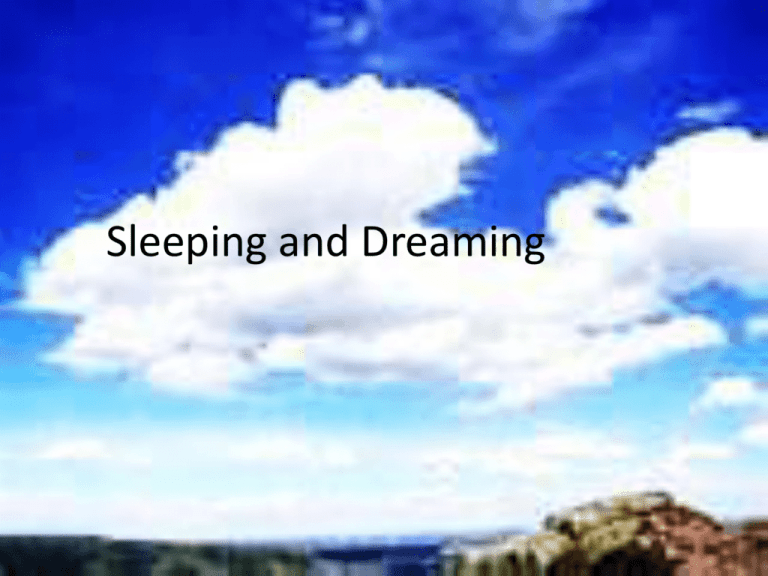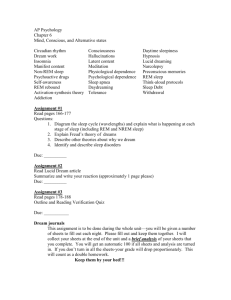Sleeping and Dreaming
advertisement

Sleeping and Dreaming Circadian Rhythm • The pattern of fluctuations in bodily processes that occur regularly each day. – Includes; sleep-wake cycles, body temperature, hormonal secretions, blood pressures and heart rate. – These patterns are synchronized with the 24 hour cycle of day and night Suprachiasmatic Nucleus (SCN) • This part of the hypothalamus known as the SCN regulates our sleep-wake cycles. • The SCN regulates the pineal gland which releases the hormone melatonin. Melatonin • Melatonin helps regulate the body’s sleepwake cycle. • Exposure to darkness during evening hours activates the production of melatonin, making us sleepy. • During light exposure, melatonin production falls off, which keeps us awake. Sleep Hours by Age Age and Condition Average Amount of Sleep per Day Newborn Up to 18 hours 1-12 months old 14-18 hours 1-3 years old 12-15 hours 3-5 years old 11-13 hours 5-12 years old 9-11 hours Adolescents 9-10 hours Adults, including elderly 7-8(+) hours Pregnant women 8(+) hours Things that affect our sleep patterns • Cloudy Days- lack of light increases melatonin levels, making us sleepy. • Time changes- People may feel sluggish during the first few days after time changes (forward or backward). • Frequent time shifts- Frequent time shifts can throw off the circadian rhythm Jet Lag • Change in local time conflicts with your internal body clock • Fall asleep earlier than usual (traveling from east to west). • Associated with irritability, fatigue, difficulty concentrating, diarrhea, headache, mild depression. • Recovery can take one day per time zone crossed. Stages of Sleep Sleep Stage Alert wakefulness Relaxed wakefulness Stage 1 sleep Stage 2 sleep Stage 3 sleep Stage 4 sleep REM sleep State of focused attention or active thought Stages of Sleep State of resting quietly w/ eyes closed Light sleep from which the person can be easily awakened Deeper sleep, but the sleeper is still readily awakened Deep sleep from which it is difficult to arouse sleeper Deepest level of sleep Sleep in which the brain becomes more active but muscle activity is blocked; stage associated with dreaming. Functions of Sleep • Protective: Keep you out of harm’s way (esp. animals) • Conserve Energy: Lower body temp. at night helps keep body temp. up during the day. • Restorative: Replenish proteins and help brain recover from wear and tear of the day. Functions of Sleep • Consolidation: Newly formed memories can be turned into lasting remembrances. • Fight Disease-causing Agents: More susceptible to common ailments due to lack of sleep Functions of Dreams • REM sleep is consolidating fresh memories into lasting ones (Huber et. al.). • Dreams help us sort through everyday problems and concerns (Hartmann). • Activation-synthesis Hypothesis: Dreams represent an attempt by the cerebral cortex to make sense of the random discharges of electrical activity that occur during REM sleep. Activation-Synthesis Hypothesis • According to this, the cerebral cortex creates a story line based on the individual’s store of knowledge and memories to explain the random signals and emotions and sensory experiences they generate. Parts of Brain • Areas in the brainstem that involve emotions, memory and visual processing are activated during REM sleep. • Areas of the brain involved in logical thought show decreased activity during REM sleep. • This is why dreams may lack order or ordinary conscious thought. Freud • Believed dreams represent a form of wish fulfillment. • Dreams contain symbols that represent the sleeper’s underlying wishes, usually of a sexual or aggressive nature. • Called dreams, the “royal road” to the unconscious mind, but you need a psychological road map to determine their true meanings. Types of Dream Content • Freud distinguished between 2 types of dream content. –Manifest Content: Manifest content refers to events that occur in the dream. Types of Dream Content – Latent Content: The true, underlying meaning of the dream, disguised in the form of dream symbols. –The disguise conceals the dream’s real meaning, helping you stay asleep instead of being awakened by emotionally threatening material. Example • Manifest Content: Having a dream where you get pulled over by a police officer for speeding and receive a ticket. • Latent Content: Driving fast may symbolize an unacceptable sexual wish. The police officer, a symbol of authority, might represent your father punishing you for having the sexual wish. More Freud • Phallic objects like; trees, skyscrapers, snakes, and guns are symbols of male genitalia. • Enclosed objects like; boxes, ovens, closets are symbols of female genitalia • Sometimes though, “a cigar is just a cigar”… Lucid Dreaming • Lucid dreams are dreams in which the person is aware that they are dreaming. • Relatively few people report experiencing lucid dreams regularly. • Some people claim to be able to control what they will dream about and direct the action of their own dream. Sleep Deprivation • Most people need between 7-9 hours of sleep to feel fully rested. (Americans-6.9) • 1 in 4 people say that sleep problems impair their ability to function during the day. • High School students: Only 15% get the 8.5 hours recommended. Sleep Deprivation • Lack of sleep can; – Slow reaction time – Impair concentration – Impair memory – Impair problem-solving ability – Make it more difficult to retain newly acquired information – Impair academic performance Sleep Deprivation • Sleep deprivation is among the most common cause of motor vehicle accidents. • Loss of REM sleep affects learning ability and memory. • Prolonged sleep deprivation can lead to hypertension, a cardiovascular disease and potential killer.





